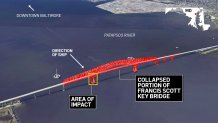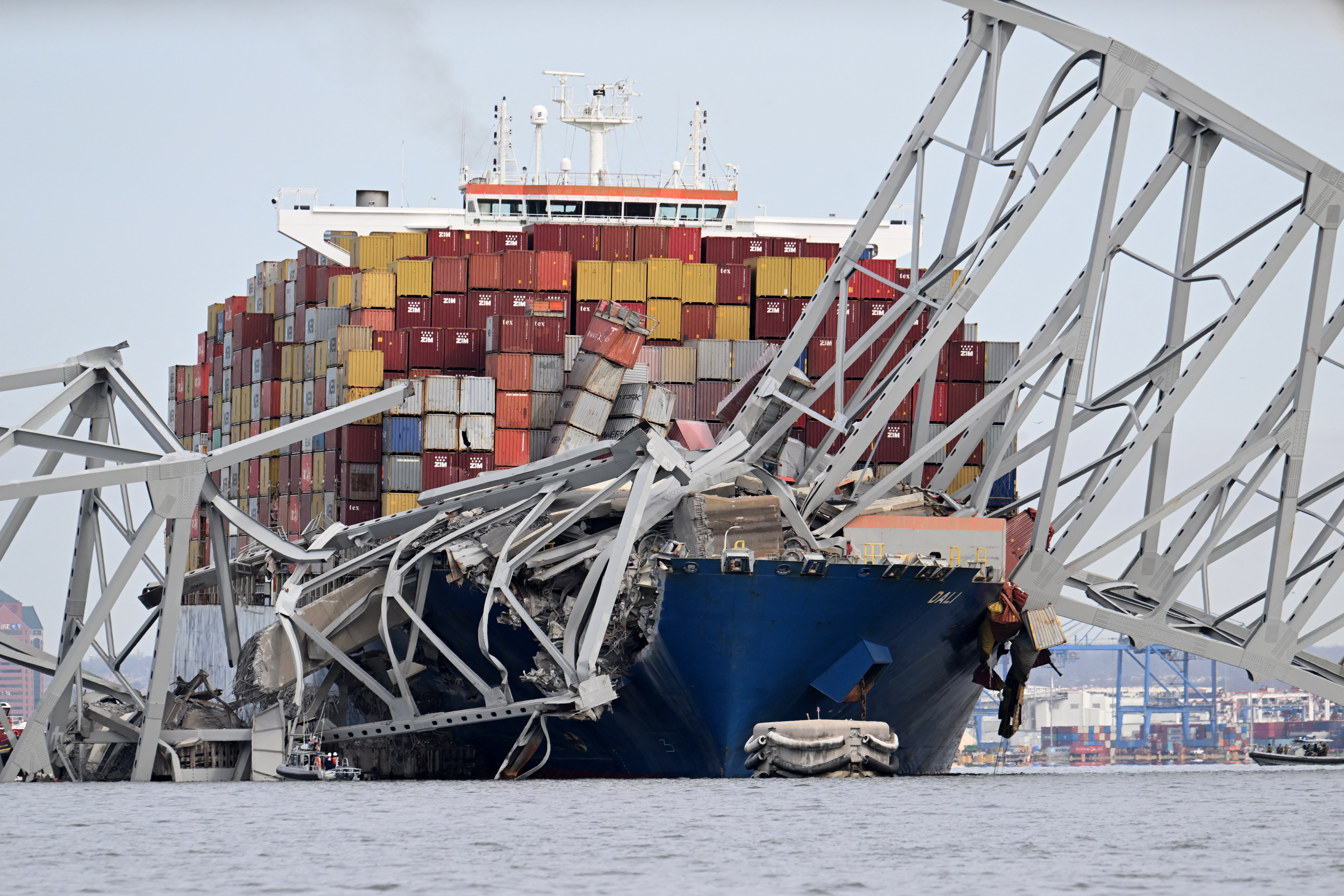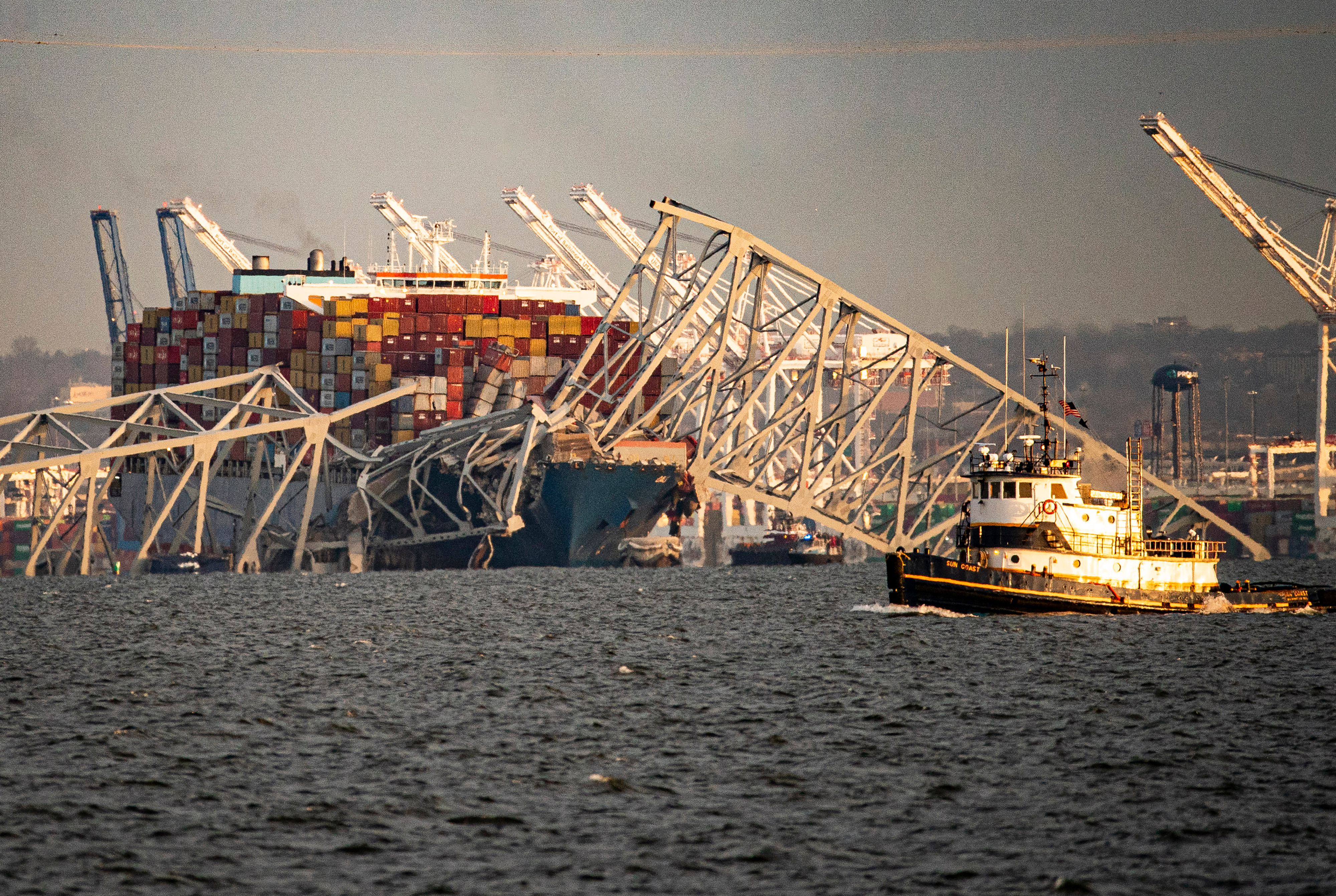Authorities are piecing together what led to the bridge collapse in Baltimore. But so far, we know that Maryland Gov. Wes Moore said a large cargo ship lost power and issued a mayday call moments before it struck the Francis Scott Key Bridge.
The span broke apart and tumbled into the Patapsco River almost instantly. Two people were rescued, but officials say six others are presumed dead. They were in a construction crew filling potholes on the bridge at the time. Ship traffic has been suspended at the Port of Baltimore, which handles tens of billions of dollars in cargo each year.
Here's what we know so far about the collapse, the victims and how the incident will impact the U.S. supply chain:
Get Tri-state area news and weather forecasts to your inbox. Sign up for NBC New York newsletters.
What exactly happened?
The operators of the Dali cargo ship issued a mayday call that the vessel had lost power moments before the crash, but the ship still headed toward the span at “a very, very rapid speed," Maryland Gov. Wes Moore said.
The 985-foot-long (300-meter-long) vessel struck one of the 1.6-mile (2.6-kilometer) bridge’s supports, causing the span to break and fall into the water within seconds.
Six construction workers who were filling potholes on the bridge are presumed dead. Jeffrey Pritzker, executive vice president of Brawner Builders, said they were working in the middle of the span when it came apart.
An inspection of the Dali last June at a port in Chile identified a problem with the ship’s “propulsion and auxiliary machinery,” according to Equasis, a shipping information system. The deficiency involved gauges and thermometers, but the website’s online records didn’t elaborate.
The most recent inspection listed for the Dali was conducted by the U.S. Coast Guard in New York in September. The “standard examination” didn’t identify any deficiencies, according to the Equasis data.
The ship was moving at 8 knots, which is roughly 9 mph (15 kph).
Given the vessel’s massive weight, it struck the bridge support with significant force, said Roberto Leon, a Virginia Tech engineering professor.
“The only way the post can resist it is by bending,” Leon said. “But it cannot absorb anywhere near the energy that this humongous ship is bringing. So it’s going to break.”
Last June, federal inspectors rated the 47-year-old bridge in fair condition. But the structure did not appear to have pier protection to withstand the crash, experts said.
“If a bridge pier without adequate protection is hit by a ship of this size, there is very little that the bridge could do,” Leon said.
Who are the missing people?
Two people were rescued, and six others are missing and presumed dead. They all were part of a construction crew that was repairing potholes on the bridge.
The ship's operator issued a mayday call moments before the crash, enabling authorities to limit vehicle traffic entering the span. The fast action by authorities likely saved lives, Moore said.
Some vehicles on the span seemed to escape with seconds to spare, and police believe the construction workers are the only people who went into the water.
Among the victims are people from Guatemala, Honduras and Mexico, according to diplomats from those countries.
Guatemala’s consulate in Maryland confirmed that two of the missing were Guatemalan citizens working on the bridge. Mexico’s Washington consulate also confirmed in a statement posted on X that Mexican citizens were among the missing but did not say how many.
The Honduran man was identified as Maynor Yassir Suazo Sandova by that country's deputy foreign affairs minister. He was a father of teenage boy and a 6-year-old girl.
"The hope we have is to be able to see the body," Suazo’s brother told NBC News. "We want to see him, find him, know whether he is dead, because we don’t know anything."
Father Ako Walker, a Catholic priest at Sacred Heart of Jesus, said outside a vigil that he spent time with the families of the workers as they waited for news of their loved ones.
“You can see the pain etched on their faces,” Walker said.
“They only tell us that we have to wait, that for now, they can’t give us information,” she said Tuesday. “[We feel] devastated, devastated because our heart is broken, because we don’t know if they’ve rescued them yet. We’re just waiting to hear any news.“
Jesús Campos said he's worked construction for Brawner Builders, alongside some of the missing, for years and that last night his coworkers were replacing concrete on the bridge.
“Watching what’s happening makes my heart hurt. We’re human beings and they’re my coworkers,” he said. “God willing, they’re alive. It’s what we’re hoping for most.”
The ship is owned by Singapore-based Grace Ocean Private Ltd., which said all crew members, including the two pilots, were accounted for and there were no reports of injuries.
How will this impact the supply chain and travel?
The collapse will almost surely create a logistical nightmare for months, if not years, in the region and beyond, shutting down ship traffic at the Port of Baltimore, a major shipping hub. The accident will also snarl cargo and commuter traffic.
The bridge was “a normal commuting route for 30,000 Marylanders every day,” Gov. Moore said. It had 185 feet (56 meters) of clearance above the water and was a key cog in the region's transportation infrastructure.
The American Trucking Association estimated some 4,900 trucks per day carrying an annual average of $28 billion worth of goods would have to be re-rerouted — at a cost to shippers and ultimately consumers
The port is a major East Coast hub for shipping. The bridge spans the Patapsco River, which massive cargo ships use to reach the Chesapeake Bay and then the Atlantic Ocean.
Baltimore is the largest entry point in the U.S. for large agriculture and construction equipment like tractors, farming combines, forklifts, bulldozers and heavy-duty trucks that are bound for the Midwest, according to DAT Freight and Analytics, a freight-exchange service, NBC News reports.
Companies may have to reroute their shipments to nearby ports, like those in Georgia or Florida, he said. That will mean higher freight shipping costs as trucks have to travel further and may have to wait longer to pick up their loads if those ports become congested, said Dean Croke, principal analyst with DAT.

"It's very difficult to estimate the [shipping] cost impact, but it’s fair to say it's going to be costlier to transport autos and trucks to and from the U.S. in the short term because of the oversize impact on the port of Baltimore," said Tinglong Dai, a professor at the Johns Hopkins Carey Business School.
Baltimore is also the No. 1 automobile port in the U.S. Other Eastern Seaboard ports are expected to be able to shoulder some Baltimore-bound auto shipments, said Emily Stausbøll, market analyst with the shipping group Xeneta, which could limit the impact on global shipping rates.
“However, there is only so much port capacity available and this will leave supply chains vulnerable to any further pressure,” Stausbøll wrote in a note to clients, according to NBC News.
The Dali was headed from Baltimore to Colombo, Sri Lanka, and flying under a Singapore flag, according to data from Marine Traffic.
President Joe Biden said he plans to travel to Baltimore “as quickly as I can” and that he expects the federal government to pick up the entire cost of rebuilding the bridge.
What other bridges have collapsed in the US?
From 1960 to 2015, there were 35 major bridge collapses worldwide due to ship or barge collisions, with a total of 342 people killed, according to a 2018 report from the World Association for Waterborne Transport Infrastructure.
Eighteen of those collapses happened in the United States.
Among them were a 2002 incident in which a barge struck the Interstate 40 bridge over the Arkansas River at Webbers Falls, Oklahoma, sending vehicles plunging into the water. Fourteen people died and 11 were injured.
And in 2001, a tugboat and barge struck the Queen Isabella Causeway in Port Isabel, Texas, causing a section of the bridge to tumble 80 feet (24 meters) into the bay below. Eight people were killed.



